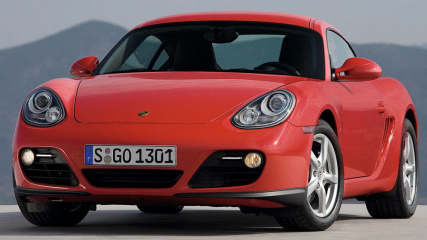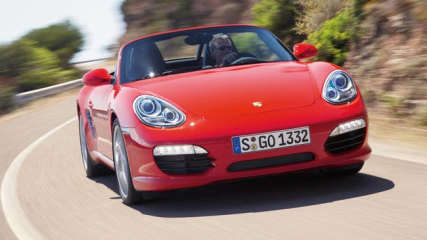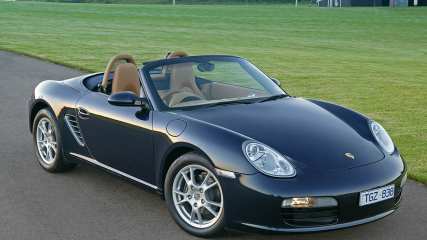Drew Gibson
By Drew Gibson · 17 Aug 2007
You see Porsches on the road every day. But it's not until you sit behind the wheel of one for a while that you realise just why serious drivers around the world adore them.When CARSguide took delivery of the recently upgraded Boxster S last week, we received a near-perfect driving experience.The Boxster has its critics, usually more seasoned Porsche purists who see the 911 as the ultimate, and only, serious Porsche.Perhaps it's because they haven't driven the perfectly balanced, highly potent and gloriously fun Boxster S.If they had, not only would they be surprised, they might even consider putting one in their garage.Maybe it's the fact that, for at least $100,000 less than a 911, you can get a true Porsche driving experience.The Boxster is the entry level Porsche (sports car, that is, not the distressingly popular 4WD Cayenne). It starts from $109,300.The Boxster S is the beefed-up version of the base model. Rather than a 2.7-litre engine, it has a 3.4- litre variant, giving it 217kW and a 0-100 km/h sprint of 5.4 seconds, compared with 180kW and a 0-100 km/h time of 6.1 seconds. The S also has 340Nm, nearly 70Nm more than the base model.All of which costs about $25,000 extra. It's a mid-engined affair, with a sublime chassis, stunning gearbox, love-it or hate-it looks with a canvas roof that, with the touch of a button, transforms the car into an open top roadster (even when the car is travelling as fast as 50km/h).Like most Porsches, it's a package that is worth a lot more than the sum of all of its parts.The legendary Stuttgart carmaker performed a bit of mid-life surgery on the Boxster earlier this year. You wouldn't know to look at it, as most of the tinkering was done on the chassis and under the bonnet.In the case of the S variant, the results are stunning.The steering, while not overly heavy, provides just about the perfect amount of feedback to allow the driver to feel the road. It's also extremely sharp and highly responsive, requiring only small amounts of input from the driver.The Boxster's optimum balance inspires confidence, perhaps even over-confidence, making it a very difficult car in which to get out of shape in, even though it tempts you to try at every winding curve.With the optional Porsche Active Suspension Management (PASM) system, a click of the button tightens up the springs for a more lively drive. And it works a treat.In normal mode, the drive is firm but not uncomfortable. Firm enough for you to avoid potholes, but not enough to shake loose your fillings.In fact, not only does the Boxster perform under pressure as well as anything you care to name, it's also easy to drive around town.The excellent torque is available down low, so you needn't constantly work the gear lever all of the time to find power. And, with a relatively heavy clutch, this is a good thing when driving in traffic.The main problem is finding the will power to resist dropping a cog or two to tap what's waiting among the higher revs, that blurt above 4500 revs that brings not only a short, sharp bust of speed, but an uncontrollable smile.On a more lazy drive, accelerating in the fifth or sixth gear at most speeds is not a problem at all, with ample pulling power at anything above about 1500 revs.Like most convertibles, the Boxster is fairly noisy with the roof down, a combination of wind, tyres on the road and peripheral noises can drown out the wonderful exhaust.Perhaps because of the positioning of the (mid) engine, the car actually sounds best when the roof is up, trapping the engine note in the cabin.Vision is improved greatly with the roof down.Aside from the canvas top, the only real giveaway inside that you're driving a convertible is the odd creak and rattle.Other than that, though, the chassis is tight as tight.Fuel consumption is relatively high, we averaged a touch above 16.5 litres per 100km in a mix of peak-hour traffic and the odd bit of spirited driving. It's unlikely any buyer would be bothered.A switchable stability control is non-intrusive enough to leave on most of the time.The brakes take quite a kick to bite hard, but have a wonderful amount of feel to them, stopping the Boxster hard, fast and straight.Inside, the cabin is a bit sparse for a $135,000 car, no steering wheel controls, no sat-nav etc but the Boxster is made to drive, not to lounge about in.Surprisingly, the stereo system was also a little below average. But, again, the engine sound track and pure driving fun makes this a near-redundant criticism.A nifty little spoiler on the back of the car pops up once you exceed the speed limit, at 120km/h, but you can also drive with a 'legal' spoiler by pressing the manual over-ride and raising it yourself.Why you would need it at slow speeds, other than to look good, is anybody's guess.For a two-seater, storage space is ample, with surprising amount of room in both the back and the front of the car.The front storage area, which is under the front bonnet where the engine normally sits in most cars, is deep and holds more luggage than you might expect, certainly enough to put in a trolley full of groceries. The back boot, although not as deep, also offers generous space.Being a true two-seater, however, there are obviously no back seats and no chance of getting more than two people in the cabin.It's a selfish car, on more than one level.But cabin goodies and luggage space are not what the Boxster is about. It's about the driving experience and, for any money, the Boxster is up there with the absolute best of them.Even though it's not a fabled 911, the way the Boxster looks, feels, handles and sounds is unmistakably Porsche. SnapshotPorsche Boxster SPrice: $134,600Engine: 3.4L/6-cyl, 217kW/340NmTransmission: 6-speed manual0-100kmh: 5.4 secs The rivalsBMW Z4 M RoadsterPrice: $130,800Engine: 3.2L/6-cyl, 252kW/365NmTransmission: 6-speed manual0-100kmh: 5.0 secs Mercedes-Benz SLK 350Price: $115,474Engine: 3.5L V6, 200kW/350NmTransmission: 7-speed auto0-100kmh: 6.0 sec (approx) Alfa Romeo Spider JTS V6Price: $94,990Engine: 3.2L V6, 191kW/322NmTransmission: 6-speed manual0-100kmh: 7.0 secs (approx)






